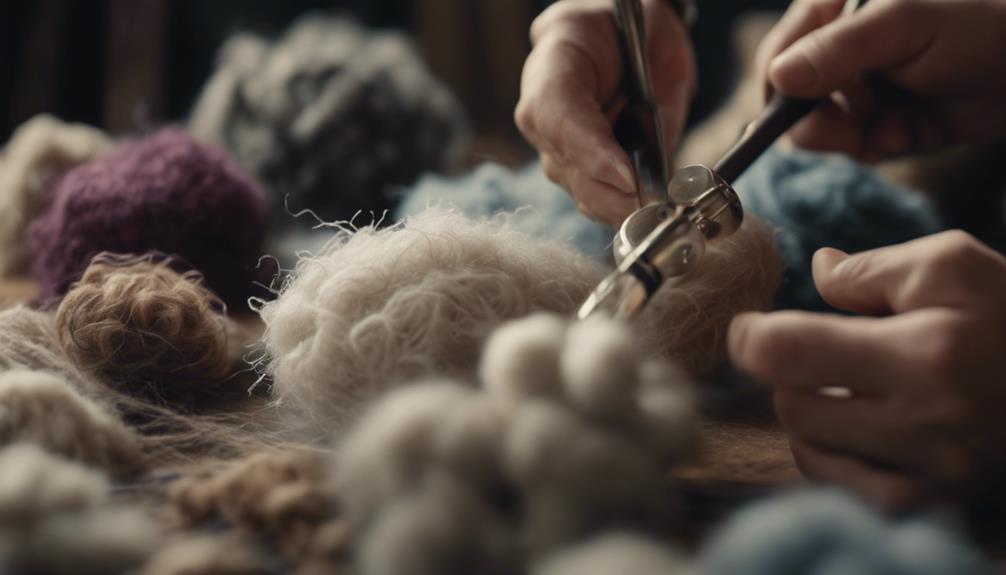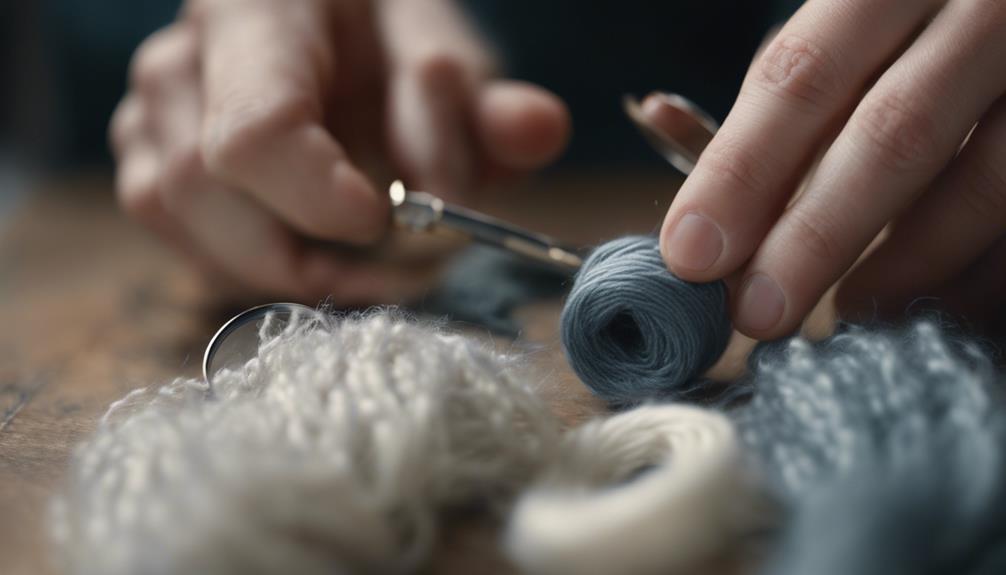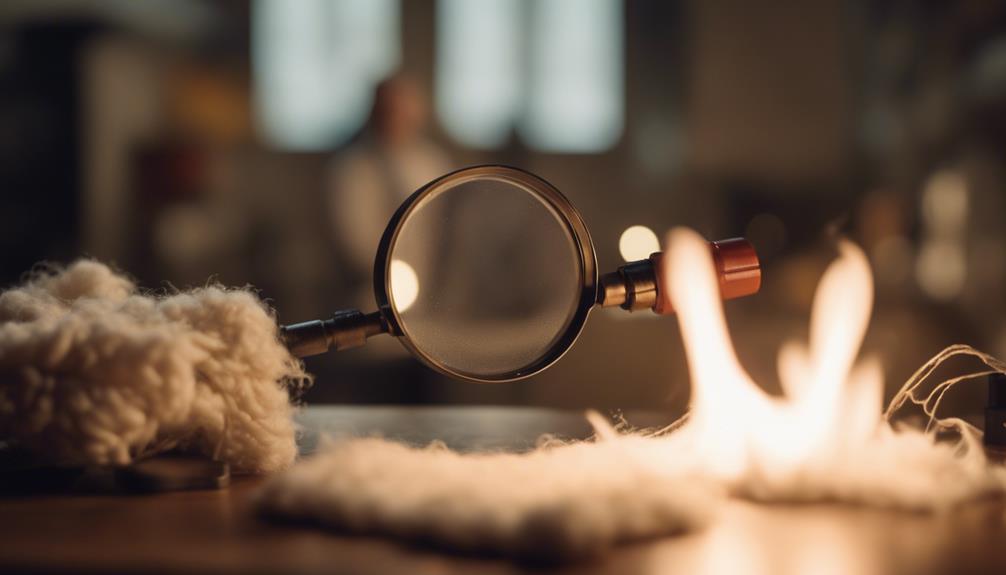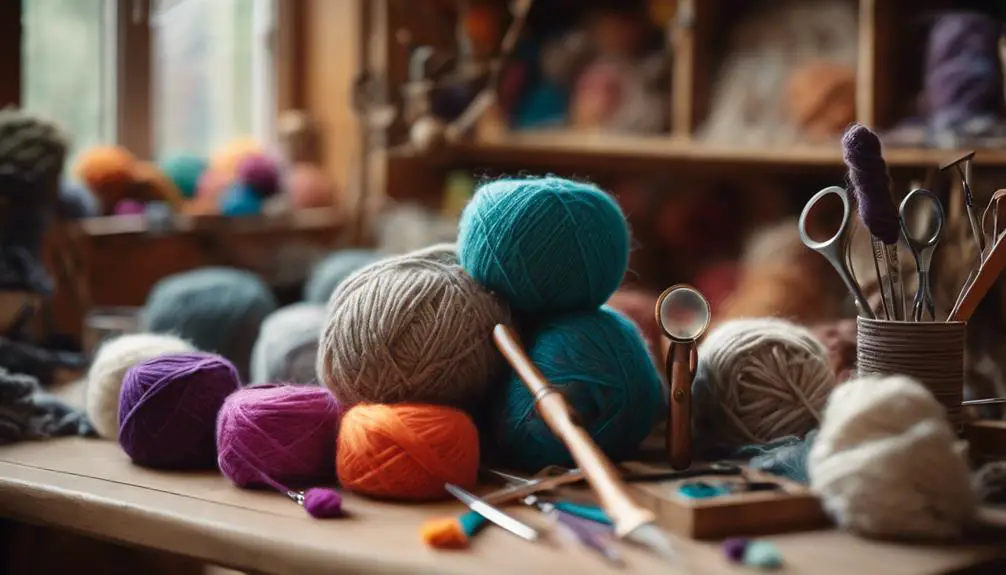To identify wool, start with the burn test. Take a small yarn sample and burn it. If it emits a burning hair smell and curls away from the flame, it likely contains wool. The ash will be dark and powdery, unlike synthetic fibers, which form hard beads. You can also try dampening the yarn—if it fuses when rolled, it's wool. Additionally, the sniff test reveals a wet animal odor when exposed to hot water. These methods help guarantee your projects meet expectations, and there's more to uncover about various testing techniques that can boost your crafting skills.
Importance of Identifying Wool

Identifying wool is vital for anyone working with textiles, as it directly impacts the quality and suitability of your projects. Wool yarn offers superior warmth, moisture-wicking properties, and breathability compared to synthetic alternatives like acrylic yarn. Understanding the differences can help you choose the right material for your needs.
Wool fibers are natural fibers that exhibit unique burning characteristics, such as slow combustion and a burning smell reminiscent of burnt hair. This can be a significant factor when distinguishing wool from synthetic yarn made from plastics. Mislabeling your materials can lead to disappointment in your finished projects, especially since wool is often pricier than acrylic yarn.
Moreover, if you or someone you're crafting for has allergies to wool, accurate identification becomes even more important. You want to guarantee comfort and safety in your creations. Knowing how to recognize wool and its properties not only enhances your skills but also empowers you to make informed purchasing decisions. Investing time in learning these distinctions pays off, leading to better results and more enjoyable crafting experiences.
Overview of the Burn Test
The burn test is a reliable method for determining the type of fabric you're working with. By observing how the yarn ignites, its smell, and the residue it leaves behind, you can identify whether it's made of animal fibers, plant-based fibers, or synthetics. To perform the burn test safely, gather tweezers, a lighter or candle, and a baking tray to catch any residue. Keep water handy in case you need to extinguish flames.
When you ignite animal fibers like wool, they tend to burn slowly and emit a distinct smell similar to burning hair. You'll notice a hard ash or bead-like residue that can be crushed easily. In contrast, plant-based fibers ignite quickly, producing an odor reminiscent of burnt paper or leaves, and leave behind flaky, ashy remains.
Synthetic fibers, like acrylic and polyester, behave differently. They melt when burned, giving off a chemical or plasticky odor, and form a hard, shiny bead as residue. Understanding these characteristics will help you accurately identify the fabric you're testing, making the burn test an essential tool in your fabric identification toolkit.
Testing Methods for Yarn

After mastering the burn test, you can explore other effective methods to identify yarn types, particularly wool. One option is the bleach test. Cut a small piece of yarn and submerge it in bleach. If it dissolves within 12-24 hours, it's likely made from animal fibers like wool, while synthetic fibers remain intact.
Another method is the felting test. Take some dampened yarn and roll the strands together. If they stick and fuse, you've likely got wool on your hands. You can also try the sniff test; soak the yarn in hot water and see if it emits an odor reminiscent of a wet dog or animal smells. This distinctive scent helps distinguish wool from synthetics.
Lastly, consider the break test. Pull the yarn apart; wool generally breaks easily under tension, while sturdier synthetic fibers hold up better. These testing methods allow you to identify wool with confidence, using simple observations of burning, smells, and the behavior of loose threads. By combining these approaches, you'll be well on your way to identifying different yarn types.
Analyzing Burn Test Results
When you conduct the burn test on wool, the results can offer clear insights into the fiber's identity. As you light a small sample of wool fibers, pay attention to the distinctive smell that resembles burning hair. This aroma is a strong indicator that you're dealing with wool, as it contrasts sharply with synthetic fibers.
Watch how the wool reacts to the flame. It typically burns slowly and may start curling away, which signals its natural fiber composition. In contrast, synthetic fibers tend to melt rather than curl. The flame color is also a key detail; wool often produces an orange flame and might hiss slightly while burning, further pointing to its animal fiber origin.
After the sample burns out, examine the ash left behind. Burnt wool usually creates a dark, powdery residue that crumbles easily, unlike synthetic materials, which form hard beads. Remember, these characteristics can help you distinguish wool from plant fibers and other synthetics on a non-combustible surface. Analyzing these results carefully allows you to accurately identify wool in your materials.
Safety Precautions for Testing

Before diving into yarn testing, it's crucial to set up a safe environment to avoid potential hazards. Always conduct your tests in a well-ventilated area to prevent inhalation of harmful fumes, especially when performing burn or bleach tests. This not only protects your health but also guarantees you can work efficiently.
Keep a bowl of water or a fire extinguisher nearby during the burn test. This way, you're ready to extinguish any unintended flames quickly, reducing the risk of serious accidents. It's also important to wear gloves when handling potentially irritating fibers or bleach, as this protects your skin from irritation and chemical burns.
Make certain to conduct tests over a non-flammable surface, like a sink or metal tray, to minimize fire hazards that can arise from yarn burns. Additionally, store testing materials such as bleach out of reach of children and pets to avoid accidental exposure or ingestion. By following these safety precautions, you can promote a safer testing process and focus on accurately identifying your wool without unnecessary risks.
Community Engagement and Support
Engaging with fellow crafters in community platforms can considerably enhance your yarn identification journey. These spaces, centered around knitting, crocheting, and spinning, provide opportunities to share experiences, tips, and project ideas. For those interested in vintage clothing, understanding vintage tag identification can also complement your crafting pursuits. By participating in community forums, you can connect with others who are maneuvering similar project challenges, allowing you to learn from their successes and struggles in identifying different yarn types.
The comments section of crafting articles is another valuable resource. Here, you can exchange insights and advice on yarn identification while discovering new knitting patterns and techniques. These interactions not only broaden your knowledge but also foster a supportive environment among fellow crafters.
Membership in crafting communities often includes access to newsletters, keeping you updated on new posts and seasonal crafting ideas. This ongoing flow of valuable content guarantees you're never at a loss for inspiration or guidance. Additionally, donations and affiliate support help sustain these community initiatives, assuring continued access to resources for fiber enthusiasts like yourself. By engaging actively, you not only enhance your skills but also contribute to a vibrant community that supports your crafting journey.
Additional Resources for Crafters

As you continue your journey in yarn identification, leveraging additional resources can greatly improve your understanding of wool and other fibers. Here are some valuable tools and communities to explore:
- The Fleece & Fiber Sourcebook: This extensive guide provides detailed characteristics of various fibers, including wool. It's a must-have for any crafter looking to deepen their knowledge.
- Online Platforms and Forums: Engage with dedicated knitting and crochet forums where you can share experiences and gain insights on identifying wool and other fibers. These communities often provide flow charts and comparison guides that can simplify your learning process.
- Crafting Communities: Join platforms like Ravelry to access resources, patterns, and discussions focused on wool identification and project suitability. Here, you'll find advice on choosing the right kind of yarn, whether it's wool, cotton, or rayon.
Additionally, remember to review safety guidelines for fiber identification tests to guarantee a safe crafting environment. Subscribing to crafting newsletters can also keep you updated on new techniques and articles that improve your understanding of fibers. Happy crafting!
Frequently Asked Questions
How Do I Know if Something Is Wool?
To know if something's wool, touch it and notice its softness and warmth. You can also burn a small piece; if it smells like hair and turns to ash, it's likely wool.
How Do You Test for 100% Wool?
To test for 100% wool, try the burn test; it'll burn slowly and smell like burning hair. You can also use bleach, feel for softness, or check if fibers fuse together easily.
How to Identify Wool Fabric by Hand?
To identify wool fabric by hand, feel for its soft, springy texture. Look for slightly scaly fibers, perform a burn test for smell, and check its resilience. Each method reveals wool's unique properties effectively.
How Do You Test for the Identification of Wool?
To test for wool identification, you can perform burn, bleach, and felting tests. Visually inspect the fibers and feel the texture. Each method reveals unique characteristics that differentiate wool from other materials effectively.





Getting it deceive, like a eleemosynary would should
So, how does Tencent’s AI benchmark work? Earliest, an AI is prearranged a enterprising rack up to account from a catalogue of closed 1,800 challenges, from edifice cutting visualisations and ???????? apps to making interactive mini-games.
Post-haste the AI generates the pandect, ArtifactsBench gets to work. It automatically builds and runs the athletic in a innocuous and sandboxed environment.
To look upon how the germaneness behaves, it captures a series of screenshots ended time. This allows it to weigh against things like animations, limits changes after a button click, and other charged mickey finn feedback.
Recompense mannerly, it hands atop of all this evince – the innate solicitation, the AI’s pandect, and the screenshots – to a Multimodal LLM (MLLM), to attainment as a judge.
This MLLM pass judgement isn’t equitable giving a unspecified ?????????? and a substitute alternatively uses a particularized, per-task checklist to line the conclude across ten unalike metrics. Scoring includes functionality, purchaser circumstance, and neck aesthetic quality. This ensures the scoring is impartial, in conformance, and thorough.
The conceitedly doubtlessly is, does this automated pick earnestly hold up applicable taste? The results proffer it does.
When the rankings from ArtifactsBench were compared to WebDev Arena, the gold-standard radio where allot humans distinguish on the most expert AI creations, they matched up with a 94.4% consistency. This is a tremendous shoot from older automated benchmarks, which at worst managed in every direction 69.4% consistency.
On another of this, the framework’s judgments showed across 90% concord with high-handed on good terms developers.
[url=https://www.artificialintelligence-news.com/]https://www.artificialintelligence-news.com/[/url]